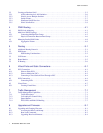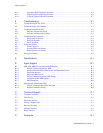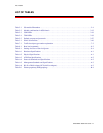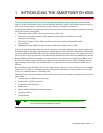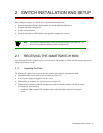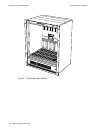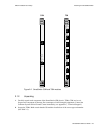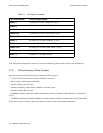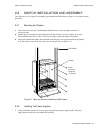
1-2 SmartSwitch 6500 User Guide
SmartSwitch 6500 Modules Introducing the SmartSwitch 6500
1.1 SMARTSWITCH 6500 MODULES
Before continuing, read the following section. This section is provided to quickly give you a better, more detailed
understanding of the function and operation of each of the SmartSwitch 6500’s modules.
1.1.1 Cell Storage Module (CSM)
CSMs provide the main switching fabric for the SmartSwitch 6500. The CSM also provides cell storage and output
queuing, and dynamically shares memory among all active connections. The CSM monitors overall utilization of
shared memory and communicates this information to the TSM modules, where it’s used in making decisions about
incoming cell-acceptance. The CSM controls TSM access to the backplane cell data busses at both ingress
(TSM-to-CSM) and egress (CSM-to-TSM). The CSM can also provide clock and sync signal generation for network
clocking.
For redundancy, the SmartSwitch 6500 supports up to two CSMs in a single 6C110 chassis. When one CSM is active,
the other CSM is in standby mode. If the active CSM fails, the standby CSM can be made to assumes the active role.
Note CSMs must reside in SmartSwitch 6C110 chassis slots nine (9) or ten (10).
1.1.2 Translation and Scheduling Module (TSM)
TSMs are responsible for SmartSwitch 6500 traffic management functions. For example, TSMs perform header
translation for ingress and egress cell traffic, provide port queue management for ABR (including EPD and PPD during
congestion), and EFCI marking for forward congestion. TSMs are responsible for per-port/per-class queue
management, cell scheduling and both physical and logical multicast support. TSMs also provide system interfaces for
the CPU modules, the SAR, and all I/O modules.
The SmartSwitch 6C110 chassis can contain up to eight TSMs, two of which can contain CPU modules. Also, each
TSM can support up to two IOMs; depending on the interface type, this provides each TSM with up to eight ATM ports.
1.1.3 CPU Module
CPU module are mounted on TSMs as a daughter cards. The CPU module runs the system software, and provides both
intra-switch and inter-switch communication for configuration and monitoring. The CPU module is also responsible
for providing both a serial and Ethernet interface, through which the user interface and network management facilities
are accessed.
Note While the CPU module provides the serial and Ethernet interfaces, the external
connectors for these interfaces reside on the CSM module.
For redundancy, the SmartSwitch 6500 allows two CPU modules (each mounted on a separate TSM) to exist within
the same SmartSwitch 6C100 chassis. When one CPU module is active, the other CPU is in standby mode. If the active
CPU module fails, the standby CPU module can be made to assumes the active role.



